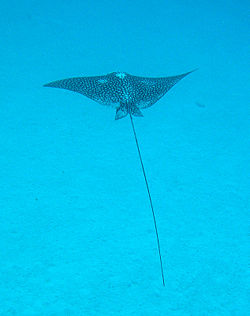Ray
| Rajiformes | ||||||||||||
|---|---|---|---|---|---|---|---|---|---|---|---|---|
 Spotted eagle ray, Aetobatus narinari
| ||||||||||||
| Scientific classification | ||||||||||||
| ||||||||||||
|
Anacanthobatidae |
In zoology, ray is the common name for cartilaginous fish comprising the order Rajiformes (or Batoidea), characterized by enlarged and flat pectoral fins continuous with the head, no anal fin, eyes on the dorsal surface, and a narrow tail. The skates comprise a family, Rajidae, within the Rajiformes, and thus can be considered a type of ray. For those taxonomic systems recognizing Batoidea as a superorder, ray may also be used as a term for members of this superorder.
Overview
The Chondrichthyes or "cartilaginous fishes" are jawed fish with paired fins, paired nostrils, scales, two-chambered hearts, and skeletons made of cartilage rather than bone. They are divided into two subclasses: Elasmobranchii (sharks, rays, and skates) and Holocephali (chimaera, sometimes called ghost sharks).
The Elasmobranchii are sometimes divided into two superorders, Selachimorpha (sharks) and Batoidea or Batidoidimorpha (rays, skates, sawfish). Nelson (1994) notes that there is growing acceptance of the view that sharks and rays together form a monophyletic group (superorder Euselachii), and sharks without rays are a paraphyletic group.
There are diverse taxonomies, and Batoidea is variously considered a superorder (eg., Taxonomicon 2007; Frisk et al. 2005; Systema Naturae 2000 2007; Rocco et al. 2007) or an order (ITIS 2007; Froese and Pauly 2005). As a superorder, Batoidea typically includes three orders: Rajiformes (true rays), Torpediniformes (electric rays), and Pristiformes (sawfishes). Some recognize additional orders such as Myliobatiformes (eagle rays) and Rhinobatiformes (guitarfishes).
Description
True rays, including skates, are placed in the order Rajiformes. Members of Rajiformes are characterized by the anterior edge of the pectoral fin, which is greatly enlarged, being attached to the side of the head anterior to the gill openings (Nelson 1994). They also have ventral gill openings, and the eyes and spiracles are on the dorsal surface (Nelson 1994). The body is normally strongly depressed and in most water for breathing is taken in through the spiracle rather than the mouth. In addition, members of Rajiformes lack an anal fin and lack a nictitating membrane with the cornea attached directly to the skin around the eyes (Nelson 1994).
Most rays give birth to live young, but the skates in family Rajidae are characterized by eggs that are encased in a horny capsule with four long tips (Nelson 1994).
ReferencesISBN links support NWE through referral fees
- Taxonomicon. 2007. Superorder Batoidea. Taxonomicon. Retrieved December 18, 2007.
- Frisk, M. G., T. J. Miller, and N. K. Dulvy. 2005. Life histories and vulnerability to exploitation of elasmobranchs: Inferences from elasticity, perturbation and phylogenetic analyses. J. Northw. Atl. Fish. Sci. 35: 27-45.
- Systema Naturae 2000. 2007. Superorder Batoidea. Systema Naturae 2000. Retrieved December 18, 2007.
- Rocco, L, I. Liguori, D. Costagliola, et al. 2007. Molecular and karyological aspects of Batoidea (Chondrichthyes, Elasmobranchi) phylogeny. Gene 389(1): 80-86.
- Integrated Taxonomic Information System (ITIS). 2007. [http://www.itis.gov/servlet/SingleRpt/SingleRpt?search_topic=TSN&search_value=563992 Batoidea
Taxonomic Serial No.: 563992]. ITIS Report. Retrieved December 18, 2007.
- * Froese, R. and D. Pauly. (Eds.). 2005. Order Rajiformes. FishBase'. Retrieved December 18, 2007.
- Batoids: Sawfishes, Guitarfishes, Electric Rays, Skates, and Sting Rays
- J. D. McEachran, K. A. Dunn, T. Miyake (1996). "Interrelationships of the batoid fishes (Chondrichthyes: Batoidea)". In Interrelationships of Fishes, Academic Press.
- Batoids: Sawfishes, Guitarfishes, Electric Rays, Skates, and Sting Rays
- J. D. McEachran, K. A. Dunn, T. Miyake (1996). "Interrelationships of the batoid fishes (Chondrichthyes: Batoidea)". In Interrelationships of Fishes, Academic Press.
- Froese, R. and D. Pauly. (Eds.). 2004. Family Rajidae: Skates. FishBase'. Retrieved December 14, 2007.
- Herbst, S. T. 2001. The New Food Lover's Companion: Comprehensive Definitions of Nearly 6,000 Food, Drink, and Culinary Terms. Barron's Cooking Guide. Hauppauge, NY: Barron's Educational Series. ISBN 0764112589.
- Marine Conservation Society. 2007. Fish to avoid: Skates and rays. Marine Conservation Society. Retrieved December 14, 2007.
- Murch, A. 2007. Shark taxonomy. Elasmodiver. Retrieved December 14, 2007.
- Nelson, J. S. 1994. Fishes of the World. New York: John Wiley and Sons. ISBN 0471547131.
- Schmid, R. E. 2007. Shark deaths upset rest of food chain: Shark overfishing may be endangering scallop populations, say scientists. Associated Press/ABCNews May 29, 2007. Retrieved December 14, 2007.
Credits
New World Encyclopedia writers and editors rewrote and completed the Wikipedia article in accordance with New World Encyclopedia standards. This article abides by terms of the Creative Commons CC-by-sa 3.0 License (CC-by-sa), which may be used and disseminated with proper attribution. Credit is due under the terms of this license that can reference both the New World Encyclopedia contributors and the selfless volunteer contributors of the Wikimedia Foundation. To cite this article click here for a list of acceptable citing formats.The history of earlier contributions by wikipedians is accessible to researchers here:
The history of this article since it was imported to New World Encyclopedia:
Note: Some restrictions may apply to use of individual images which are separately licensed.